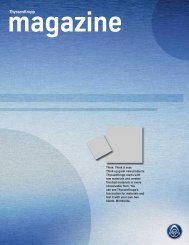Financial Statements and Management Report - Thyssenkrupp
Financial Statements and Management Report - Thyssenkrupp
Financial Statements and Management Report - Thyssenkrupp
You also want an ePaper? Increase the reach of your titles
YUMPU automatically turns print PDFs into web optimized ePapers that Google loves.
2.3 <strong>Financial</strong> statements Notes<br />
General<br />
ThyssenKrupp AG is the strategic corporate headquarters in charge of<br />
managing the ThyssenKrupp Group. Operating business is the<br />
responsibility of the Group companies. The management function of<br />
ThyssenKrupp AG involves the allocation of Group companies to<br />
business areas within the Group as well as the establishment,<br />
acquisition <strong>and</strong> disposal of other companies, groups of companies <strong>and</strong><br />
investments in other companies.<br />
The financial statements <strong>and</strong> management report as well as the<br />
consolidated financial statements <strong>and</strong> management report on the<br />
Group of ThyssenKrupp AG for fiscal year 2010/2011 together with the<br />
auditors’ report on each document, the report by the Supervisory<br />
Board, the declaration of conformity <strong>and</strong> the proposed profit<br />
appropriation are published in the electronic Federal Gazette<br />
"Bundesanzeiger". They will be accessible at www.thyssenkrupp.com<br />
(Investor Relations/Annual General Meeting). They can also be ordered<br />
from ThyssenKrupp AG, ThyssenKrupp Allee 1, 45143 Essen,<br />
Germany.<br />
Overview of transition at October 1, 2010:<br />
Assets<br />
Note<br />
HGB old<br />
Sept. 30, 2010<br />
- EUR -<br />
To improve the clarity of presentation, items are combined in the<br />
statements of financial position <strong>and</strong> income. They are shown<br />
separately in the Notes.<br />
Accounting <strong>and</strong> valuation principles under commercial law:<br />
The financial statements are drawn up in accordance with the rules of<br />
the German Commercial Code (H<strong>and</strong>elsgesetzbuch, HGB) as amended<br />
by the Accounting Law Modernization Act (Bilanzrechtsmodernisierungsgesetz,<br />
BilMoG), which entered into force on May 29, 2009,<br />
(HGB as amended), <strong>and</strong> the Stock Corporation Act (Aktiengesetz,<br />
AktG). The amended rules are adopted for the first time for fiscal year<br />
2010/2011. The prior-year figures have not been restated. In<br />
connection with the first-time adoption of the BilMoG, minor<br />
adjustments (see table) were transferred to retained earnings effective<br />
October 1, 2010 without passing through the income statement.<br />
HGB BilMoG<br />
Oct. 01, 2010<br />
- EUR -<br />
Change<br />
- EUR -<br />
With income<br />
statement<br />
effect<br />
- EUR -<br />
33<br />
Transfer<br />
to retained<br />
earnings<br />
- EUR -<br />
Receivables from Federal Employment Agency<br />
relating to partial retirement 3 7,348.00 7,393.00 45.00 45.00 —<br />
Equity <strong>and</strong> liabilities<br />
Accrued pension <strong>and</strong><br />
similar obligations<br />
- Pension provisions 7 (372,259,550.00) (383,076,128.00) (10,816,578.00) (10,816,578.00) —<br />
- Partial retirement provisions 7 (11,981,044.00) (12,664,494.00) (683,450.00) (683,450.00) —<br />
Other non-current provisions 7 (280,675,867.03) (288,263,635.59) (7,587,768.56) (7,696,503.00) 108,734.44<br />
Total (19,087,751.56) (19,196,486.00) 108,734.44<br />
Intangible assets are stated at purchase cost <strong>and</strong> amortized over their<br />
expected useful life (generally 5 years). Impairment is charged where<br />
necessary.<br />
Property, plant <strong>and</strong> equipment are stated at purchase or manufacturing<br />
cost. Interest on borrowings is not capitalized. Depreciation is charged<br />
over the useful life of the asset. Impairment is charged where<br />
necessary.<br />
Depreciation is based mainly on the following useful lives: Buildings<br />
20 - 33 years, l<strong>and</strong> improvements 5 - 20 years, other equipment 3 - 25<br />
years <strong>and</strong> factory <strong>and</strong> office equipment 3 - 10 years.<br />
Depreciation of movable assets is charged by the straight-line method.<br />
In the year of addition depreciation is charged pro rata temporis. Items<br />
with a purchase or manufacturing cost up to <strong>and</strong> including €150 are<br />
written down to zero in the year of addition. Additions within a fiscal

















